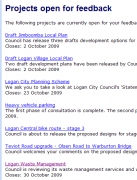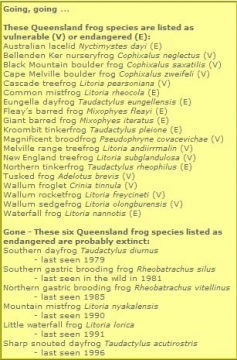
Logan and Albert Conservation Association

Glossy Black-Cockatoos are labelled as Vulnerable in Queensland and Threatened on a National Level. Presently, little is known about the current movements of the Glossy's populations and their specific habitat selection.
The Glossy Black-Cockatoo is located in the South-Eastern corner of Queensland, Eastern New South Wales, extending slightly into Victoria with populations known in South Australia and Kangaroo Island.
Glossy Black-Cockatoos are specialized feeders of Allocasuarina seeds (Allocasuarina torulosa, Allocasuarina littoralis) and some Casuarina species (Casuarina equisetifolia). They feed from the seeds located within the barky cone. Allocasuarina species are frequent in the Gold Coast and South-east Queensland region. These trees grow throughout Logan and Scenic Rim Region. Allocasuarina littoralis grows extensively in south west Logan - an area targeted by state government and Logan council as identified future growth areas. Allocasuarina torulosa grows extensively in the ranges and higher ridges of Scenic Rim.
Population
Total population estimates as of 2006 were less then 18 000. As of 2005, there was a declining population of Glossy Black-Cockatoos in Queensland, with estimates of population numbers being between 1000 and 2500. On the Gold Coast population numbers are unknown.
Conservation status and threats
All states in which Glossy Black-Cockatoos are located have been labeled Vulnerable or Endangered. The Australian Government has declared the status of the Glossy Black-Cockatoo, on a national level, as Threatened.
Roosting/breeding trees are being cleared throughout the South-Eastern Queensland region. Suitable trees for breeding are usually large with the presence of hollows in which the cockatoos can adequately roost and breed. Native Australian trees, like Eucalyptus Species, take a considerable amount of time to form large hollows.
Identification
Females can be told apart from males via blotches of yellow located on the head and neck. The head may also be darker then the male. Juveniles will also have a darker head with small spots on the shoulder or breast.
Feeding
Glossy Black-Cockatoos feed on the seeds of Allocasuarina species with the Black She-Oak (Allocasuarina littoralis) being the favored Allocasuarina species. They have been recorded spending approximately 88% of the day foraging for Allocasuarina seeds.
Breeding
Breeding occurs every two years with a single egg being laid in late January to early June with a longer nestling period then any other cockatoos (up to 90 days). Large hollow trees are needed for a breeding site and they are known to have a breeding life span that can exceed 30 years.
Dr Guy Castley from Griffith University is leading The Glossy Black-Cockatoo project which aims to assess the current distribution and habitat use of Glossy Black-Cockatoos in the Gold Coast area in order to ensure that habitat preservation for the Glossy Black-Cockatoo can be made with greater accuracy and ensure their survival in the future.
The Sustainable Planning Act 2009 (SPA) ( 2.6 MB) was passed by Parliament on 16 September 2009. Queensland government anticipates that the Act will come into effect in late 2009. This Act implements a number of the reform actions in Planning for a Prosperous Queensland - A reform agenda for planning and development in the Smart State ( 970 KB).
Transitioning from the Integrated Planning Act to the Sustainable Planning Act
The transitional provisions have been designed to minimise disruption and to ensure that all processes commenced under the Integrated Planning Act 1997 (IPA) can be completed under the IPA.
Read a short summary of the changes ( 98 KB). This change has been made to reflect a stronger focus on achieving ecological sustainability. The process for asking a local government to apply a superseded planning scheme has been simplified. Also, the timeframe for making an application under a superseded planning scheme has been reduced from 2 years to 1 year. This change is intended to give the new planning instrument, which reflects current planning standards, its full effect more quickly. It also means
that compensation is limited to those persons with an immediate intention to realise their development rights.
The process for making or amending a local planning instrument has been moved from the Act to a statutory guideline. This will enable more flexibility to ensure that planmaking
is continuously improved and reflects current drafting standards.
The Minister's powers to direct local governments to make or amend a local planning instrument have been expanded to enable the Minister:
? to direct a local government to amend a local planning instrument to make it consistent with the standard planning scheme provisions
? to make or amend a local planning instrument where urgent action is necessary to protect or give effect to a state interest, without first giving a direction to the local government
?to amend a local planning instrument, or multiple local planning instruments, to reflect the standard planning scheme provisions without first giving a direction to the local government.
Further information is available at http://www.dip.qld.gov.au/planning-reform/index.php
Integrated Planning Act 1997 (IPA) will be replaced by the Sustainable Planning Act 2009 (SPA).
The government claims it will "Focus on sustainable outcomes"
The new legislation requires a shift away from focusing on planning processes to the delivery of sustainable outcomes - encouraging active community participation in the planning and development assessment system.
It remains for the community to be active in all available processes and ensuring all levels of government hear what it is that the community wants. Development for profit without protecting biodiversity ecosytems and all extant endemic species is not sustainability - ecologically sustainable development must begin NOW!
Species extinction is a natural process and would occur without human actions. However, biodiversity loss has accelerated massively in recent years. Species are becoming extinct at a rate that has not been seen since the last global mass-extinction event.
The fossil record shows that the background extinction rate for marine life is 0.1-1 extinctions per million species per year; for mammals it is 0.2-0.5 extinctions per million species per year16. Today, the rate of extinction of species is estimated to be 100 to 1,000 times more than what could be considered natural. As with climate change, human activities are the main cause of the acceleration. Changes in land use exert the most significant effect. These changes include the conversion of natural ecosystems into agriculture or into urban areas; changes in frequency, duration or magnitude of wildfires and similar disturbances; and the introduction of new species into land and freshwater environments. The speed of climate change will become a more important driver of change in biodiversity this century, leading to an accelerating rate of species loss. Up to 30% of all mammal, bird and amphibian species will be threatened with extinction this century.
Biodiversity loss occurs at the local to regional level, but it can have pervasive effects on how the Earth system functions, and it interacts with several other planetary boundaries. For example, loss of biodiversity can increase the vulnerability of terrestrial and aquatic ecosystems to changes in climate and ocean acidity, thus reducing the safe boundary levels of these processes.
 To avoid catastrophic environmental change humanity must stay within defined 'planetary boundaries' for a range of essential Earth-system processes, argue Johan Rockström and his co-authors in a Nature Feature. If one boundary is transgressed, then safe levels for other processes could also be under serious risk, they caution. Seven expert commentaries respond to this proposal in Nature Reports Climate Change. Join the debate and listen to the podcast.
To avoid catastrophic environmental change humanity must stay within defined 'planetary boundaries' for a range of essential Earth-system processes, argue Johan Rockström and his co-authors in a Nature Feature. If one boundary is transgressed, then safe levels for other processes could also be under serious risk, they caution. Seven expert commentaries respond to this proposal in Nature Reports Climate Change. Join the debate and listen to the podcast.
Society is coming to realise that the provisions of earth are finite and we are consuming at rates beyond what can be sustained, and we do not know with any precision how close we are to our limits or what happens if we cross them.
In the latest issue of Nature is a groundbreaking new paper called "Planetary Boundaries: A Safe Operating Space for Humanity." In it, a team of 28 scientists has identified 10 separate biophysical systems crucial to humanity's flourishing; for each system they have identified a "safe operating boundary" within which humanity must remain if it wishes to maintain the basic environmental conditions in which it evolved.
The feature article can be read here. Seven expert commentaries respond to this proposal in Nature Reports Climate Change. Join the debate and listen to the podcast also from that link.
The scientists have identified the Earth-system processes and associated thresholds which, they believe, if crossed, could generate unacceptable environmental change. They have found nine such processes for which they believe it is necessary to define planetary boundaries: climate change; rate of biodiversity loss (terrestrial and marine); interference with the nitrogen and phosphorus cycles; stratospheric ozone depletion; ocean acidification; global freshwater use; change in land use; chemical pollution; and atmospheric aerosol loading.
Institute for Sustainable Futures (ISF) and Brisbane-based engineering firm Cardno has found that the Traveston Crossing dam scheme is neither necessary nor desirable.
A review of water options for South East Queensland, undertaken for the Mary River Council of Mayors, has investigated proposed water supply projects and current and predicted demand for water in South East Queensland (SEQ). The review was undertaken by (ISF) and Cardno and it has found that the Traveston Crossing dam scheme is neither necessary nor desirable.
Growth head and shoulders above India newspapers Australia wide 22 and 23 September reported on the escalating population of Australia. Economists continue to view this with enthusiasm - unlike those of us - who like MP Kelvin Thomson do not subscribe to the view that more is better and essential for economic growth. Humans are consuming resources at an unsustainable rate and overconsumption will increase our production of greenhouse gases.
More Australians will mean more greenhouse gases - whether our population increase is natural with our increasing fertility rates or through immigration. The Sydney Morning Herald and newspapers Australia wide are reporting that AUSTRALIA is poised to be the world's fastest growing industrialised nation over the next four decades, with a rate of population growth higher even than India. An economist at the Grattan Institute, Saul Eslake, said strong population growth was one of the main reasons Australia had recently avoided a recession. Economic output per head declined for four consecutive quarters, but because there were more people, the economy still recorded growth.
KELVIN THOMSON JOINS POPULATION ROLL OF HONOUR
Kelvin Thomson's brilliant speech on population in Federal Parliament Monday 17 August 2009 allows him to be placed on an Australian honour roll of politicians who understand the detrimental impacts of population growth, according to Sustainable Population Australia Inc (SPA).
SPA's national president, Sandra Kanck, says this honour roll also includes former Queensland Sustainability Minister Andrew McNamara as well as two South Australian politicians: independent Member for Fisher, Bob Such, and the Liberal Member for Mackillop, Mitch Williams.
Kelvin Thomson is the Labor Member for the seat of Wills. His speech can be found at http://www.kelvinthomson.com.au/speechesdocs/090817%20PopulationHansard.pdf
It is a remarkable speech by Kelvin Thomson .
 YOU CAN HELP SHAPE THE FUTURE OF OUR HOME -
YOU CAN HELP SHAPE THE FUTURE OF OUR HOME -
but only if you tell all levels of government what you want
HOW DO WE MEASURE PROGESS?
IS EXTINCTION OF THE LOCAL KOALA to be the cost of building houses shops powerlines and roads
URBAN EXPANSION = KOALA EXTINCTION
SEQRP = PLAN FOR EXTINCTION OF LOCAL KOALAS
The Logan City council planning scheme is being reviewed to combine 3 plans into one. The first round of community comment is in relation to the Statement of Proposals. This is a 20 page document with comments due by 23 October 2009. This link gives you that document.
In March 2008, as a result of local government reform, Logan City's boundaries were expanded to include part of Gold Coast City and part of the former Beaudesert Shire. Logan City Council sees itself as an accommodating partner in the Bligh government's SEQRP - a plan supposedly to manage the growth that is coming. As it stands now. the South East Regional Plan - and local town plans that endorse and even extend the urban footprint - as Logan requested - are plans that are annihilating koala habitat and therefore the local koala. Submissions may include why you support or oppose what Council is proposing, other issues you think need to be considered.
 The Australian Youth Climate Coalition and World Vision, through this Youth Decide vote, www.youthdecide.com.au have created an opportunity for young Australians to lay their cards on the table and express what kind of future they want to choose.
The Australian Youth Climate Coalition and World Vision, through this Youth Decide vote, www.youthdecide.com.au have created an opportunity for young Australians to lay their cards on the table and express what kind of future they want to choose.
This campaign is original and creative enough to cut through. The young organizers can help to present a unified youth voice calling for a very different kind of future to the path we're currently on.
Voting opens Monday 14th and closes Monday 21st September and if you're aged 12 - 29 and live in Australia you're eligible to vote. Choose wisely - it's your future.
 Wildlife Queensland reports that Queensland has 124 species of frog, more than any other Australian state. Within the coastal region 48% of Queensland's frog species live below 100m altitude. They are the species most threatened by habitat loss and degradation.
Wildlife Queensland reports that Queensland has 124 species of frog, more than any other Australian state. Within the coastal region 48% of Queensland's frog species live below 100m altitude. They are the species most threatened by habitat loss and degradation. Currently, 25 Queensland frog species are listed as vulnerable to extinction or endangered, but this list is growing - 6 of these species may already be extinct.
Locally at Jerry's Downfall we have habitat and home for the vulnerable Wallum frogs.
The threats
1. Habitat loss
Frogs need native vegetation but they are losing their habitat through Land clearing and urbanisation, industry and associated infrastructure, especially in coastal south-east Queensland.and Intensive agriculture.
2. Habitat degradation
Frogs and tadpoles need clean water to breed and grow. Water bodies are becoming less suitable for frogs because:
Pollution, including nutrients, runs off from lawns, gardens and agriculture.
Pesticides, especially in urban areas, are toxic to frogs.
Weeds from agriculture are taking over frog-friendly wet forests and altering water chemistry.
Changes in stream and wetland hydrology make wetlands [ the habitat of the wallum sedgefrog] unsuitable for frog breeding.
Development is disturbing acid sulphate soils, which upsets the water's pH balance.
3. Global warming
Reduced rainfall and increased temperatures will affect frog species.
Rising sea levels might affect frogs in coastal areas, for example, the wallum sedgefrog
4. Disease
An introduced fungal disease is killing upland rainforest frogs as well as affecting more common species like the green tree frog. Even apparently common species like the green treefrog (Litoria caerulia) are threatened by exotic diseases.
5. Exotic fish
Mosquito fish (Gambusia holbrooki), introduced to control mosquito larvae, eat frogspawn and tadpoles.
Aquarium fish and other exotics are a threat to frogs if released into to the wild.
What you can do
Conserve frog habitats along streams, gullies and rivers.
Conserve wetlands, especially seasonally flooded areas and ephemeral wetlands - such as melaleuca swamps.
Never let soaps, detergents or pesticides flow into stormwater drains or waterways.
Create frog-friendly gardens by encouraging naturally occurring trees, shrubs and ground covers.
Lobby local and State governments to value and protect native vegetation, particularly creekside and low-lying areas.
Lobby local and State governments to control development including managing stormwater runoff and retaining native vegetation.
Reduce your own greenhouse gas emissions that contribute to global warming.
Reduce the spread of disease among amphibian populations by not moving frogs and tadpoles from one place to another.
Prevent the spread of exotic and aquarium fish into waterways.